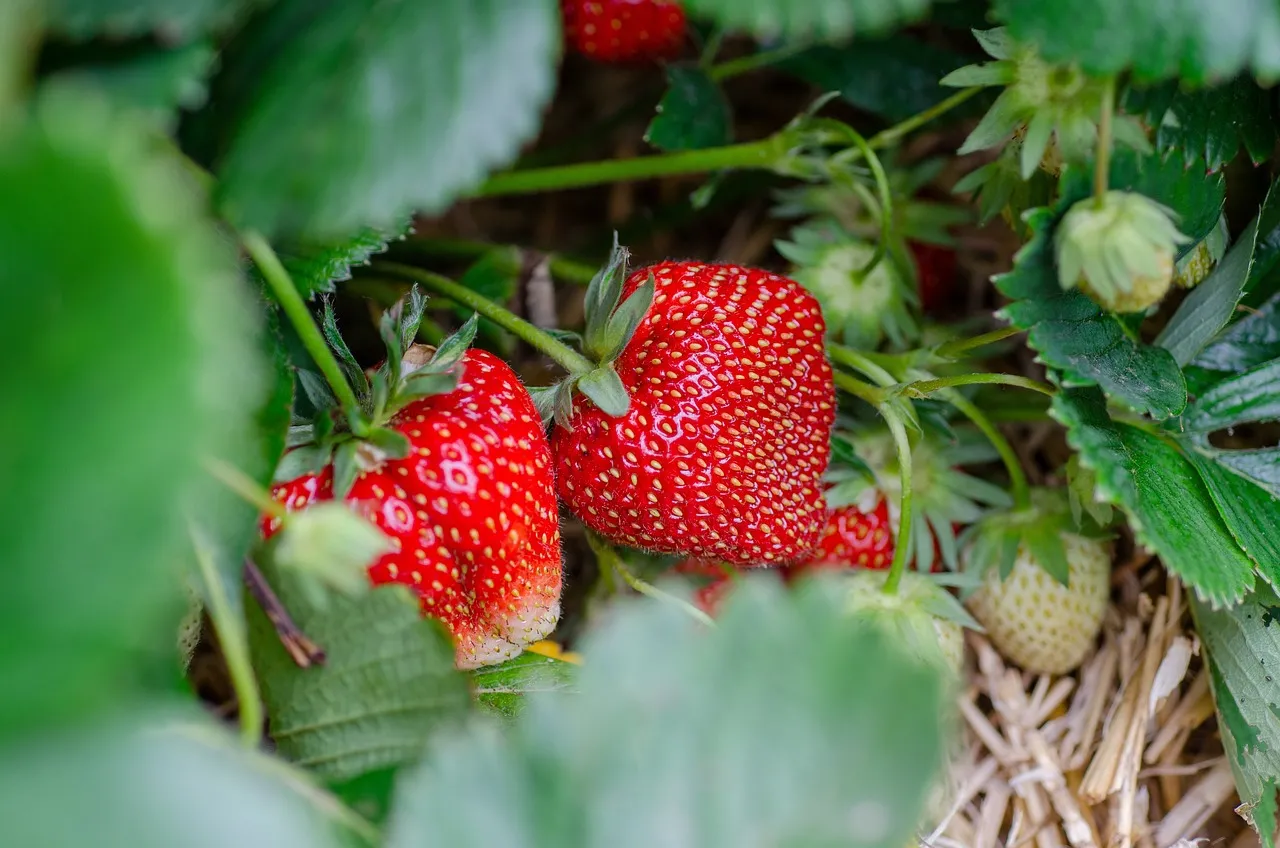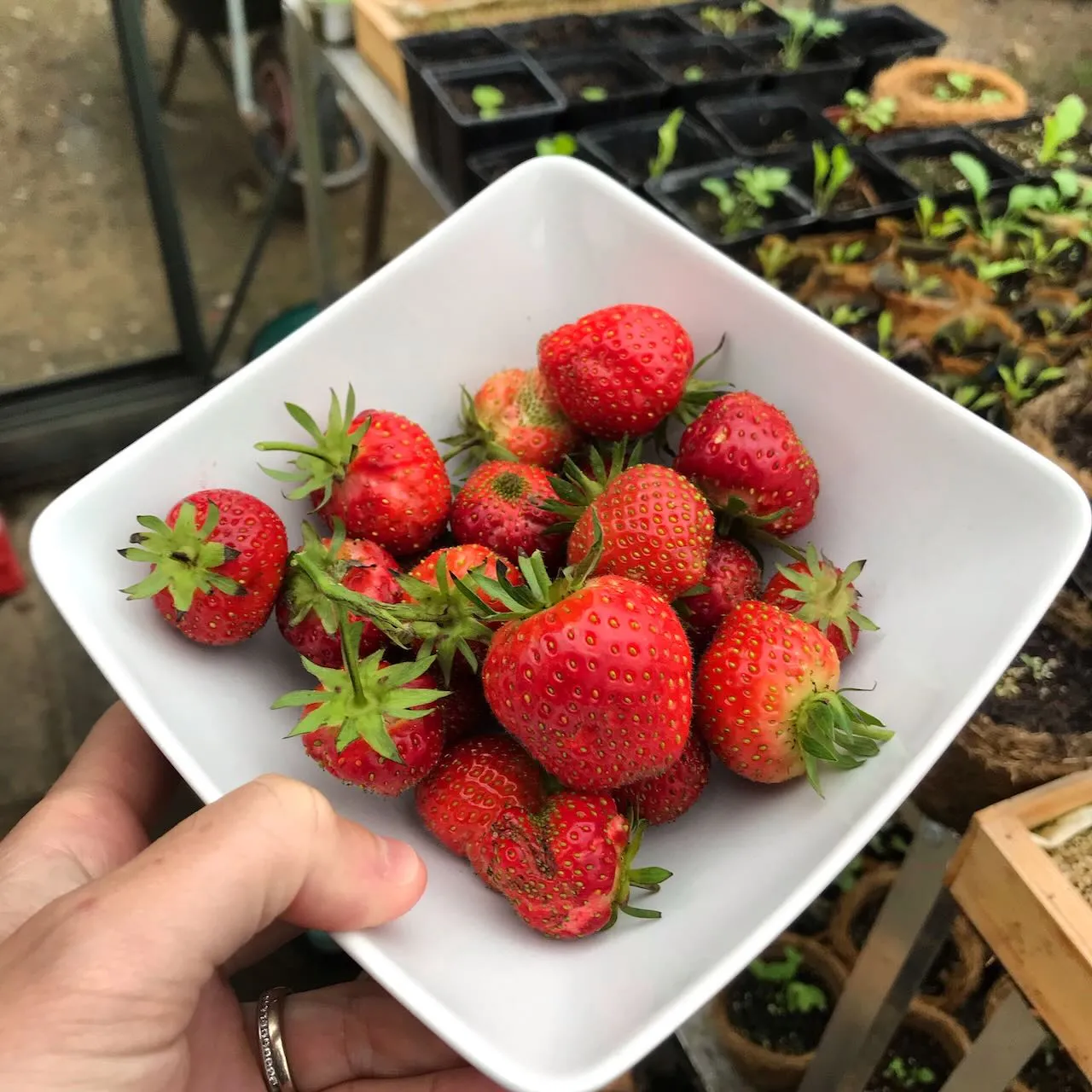Hi @emmag
Welcome to the Garden Ninja forum and community. there are no silly gardening questions here!
Strawberries are perennial fruit plants, meaning they come back year after year; because of this, they are relatively hardy and can even survive frost. So don't panic about babysitting your new strawberry plants too much. They will be fine outside as long as they don't dry out completely or freeze solid.

I'd place them under a porch or next to a shed or garage for a bit of protection on a tray so you can water them easily. They don't need flooding with water, but I'd leave them in pots until March, when I would then plant them either into the ground or containers. Watch my potting on guide below to see how to do this or read my guide here to potting on seedlings.
https://youtu.be/seGiNYRhaZE
I've also provided some detail on how to care for strawberries below since you're new!
1. Planting Your Strawberries
Location - Choose a sunny spot. Strawberries need at least 6–8 hours of sunlight per day.
Soil - Use well-drained, nutrient-rich soil with a slightly acidic pH (5.5–6.5). Add compost or organic matter to improve fertility.
Spacing - Plant strawberries 12–18 inches apart, with rows 2–3 feet apart to allow for runners.
Depth - Plant so the crown (the part where leaves meet roots) is just above the soil line to prevent rot.
Garden Ninja Tip: If space is limited, plant strawberries in a raised bed or container with good drainage.
2. Watering
Strawberries like consistently moist but not waterlogged soil. Water them deeply 1–2 times a week, depending on rainfall and weather. Use a soaker hose or water at the base to avoid wetting leaves, which can encourage plant diseases. Read more on plant diseases here.
3. Mulching Strawberries
Apply a layer of mulch (straw, pine needles, or wood chips) around your plants to:
- Keep soil moist.
- Suppress weeds.
- Protect fruit from touching the soil and rotting.
This is a key step to ensuring the strawberries also don't start to mould or rot as they develop, you can use animal bedding hay from a pet store if need be too!

4. Feeding Your Strawberries
Strawberries are light feeders, but they’ll benefit from occasional feeding:
- Before planting: Add compost or slow-release fertilizer to the soil, or if planting directly into compost, then that is enough.
- During growth: Use a balanced fertilizer (e.g., 10-10-10) once in early spring and again after the first harvest to encourage more fruiting.
https://youtu.be/5BhGtCjT2TQ
5. Pruning and Removing Runners
Strawberries send out runners (long stems with baby plants), which can reduce fruit production if left unchecked.
- Pinch off runners to focus energy on fruiting.
- After fruiting, trim back old or yellow leaves to keep plants healthy and tidy.
6. Protecting Your Plants
- Pests: Birds love strawberries! Protect them with netting or floating row covers.
- Diseases: Avoid overcrowding to improve airflow and prevent fungal diseases like powdery mildew.
7. Winter Care
In colder climates, strawberries go dormant in winter. Protect them by:
- Adding a thick layer of straw mulch after the first frost to insulate the crowns.
- Removing the mulch in spring when growth resumes.
8. Harvesting
Strawberries are ready to pick when they’re fully red and fragrant. Harvest them in the morning when they’re cool and firm, and handle them gently to avoid bruising.
10. Rejuvenating Your Plants
Strawberry plants typically produce their best fruit in the first 2–3 years. After that, older plants should be replaced with new runners or fresh plants to maintain productivity. I tend to split mine every few years by pinning down the runners until they reroot, then detaching them from the main mother plant.
I hope that helps. Let us know how you get on with your strawberries!
All the best
Lee Garden Ninja
Hi @emmag
Welcome to the Garden Ninja forum and community. there are no silly gardening questions here!
Strawberries are perennial fruit plants, meaning they come back year after year; because of this, they are relatively hardy and can even survive frost. So don't panic about babysitting your new strawberry plants too much. They will be fine outside as long as they don't dry out completely or freeze solid.

I'd place them under a porch or next to a shed or garage for a bit of protection on a tray so you can water them easily. They don't need flooding with water, but I'd leave them in pots until March, when I would then plant them either into the ground or containers. Watch my potting on guide below to see how to do this or read my guide here to potting on seedlings.
I've also provided some detail on how to care for strawberries below since you're new!
1. Planting Your Strawberries
Location - Choose a sunny spot. Strawberries need at least 6–8 hours of sunlight per day.
Soil - Use well-drained, nutrient-rich soil with a slightly acidic pH (5.5–6.5). Add compost or organic matter to improve fertility.
Spacing - Plant strawberries 12–18 inches apart, with rows 2–3 feet apart to allow for runners.
Depth - Plant so the crown (the part where leaves meet roots) is just above the soil line to prevent rot.
Garden Ninja Tip: If space is limited, plant strawberries in a raised bed or container with good drainage.
2. Watering
Strawberries like consistently moist but not waterlogged soil. Water them deeply 1–2 times a week, depending on rainfall and weather. Use a soaker hose or water at the base to avoid wetting leaves, which can encourage plant diseases. Read more on plant diseases here.
3. Mulching Strawberries
Apply a layer of mulch (straw, pine needles, or wood chips) around your plants to:
- Keep soil moist.
- Suppress weeds.
- Protect fruit from touching the soil and rotting.
This is a key step to ensuring the strawberries also don't start to mould or rot as they develop, you can use animal bedding hay from a pet store if need be too!

4. Feeding Your Strawberries
Strawberries are light feeders, but they’ll benefit from occasional feeding:
- Before planting: Add compost or slow-release fertilizer to the soil, or if planting directly into compost, then that is enough.
- During growth: Use a balanced fertilizer (e.g., 10-10-10) once in early spring and again after the first harvest to encourage more fruiting.
5. Pruning and Removing Runners
Strawberries send out runners (long stems with baby plants), which can reduce fruit production if left unchecked.
- Pinch off runners to focus energy on fruiting.
- After fruiting, trim back old or yellow leaves to keep plants healthy and tidy.
6. Protecting Your Plants
- Pests: Birds love strawberries! Protect them with netting or floating row covers.
- Diseases: Avoid overcrowding to improve airflow and prevent fungal diseases like powdery mildew.
7. Winter Care
In colder climates, strawberries go dormant in winter. Protect them by:
- Adding a thick layer of straw mulch after the first frost to insulate the crowns.
- Removing the mulch in spring when growth resumes.
8. Harvesting
Strawberries are ready to pick when they’re fully red and fragrant. Harvest them in the morning when they’re cool and firm, and handle them gently to avoid bruising.
10. Rejuvenating Your Plants
Strawberry plants typically produce their best fruit in the first 2–3 years. After that, older plants should be replaced with new runners or fresh plants to maintain productivity. I tend to split mine every few years by pinning down the runners until they reroot, then detaching them from the main mother plant.
I hope that helps. Let us know how you get on with your strawberries!
All the best
Lee Garden Ninja
 Lee Burkhill: Award Winning Designer & BBC 1's Garden Rescue Presenters Official Blog
Lee Burkhill: Award Winning Designer & BBC 1's Garden Rescue Presenters Official Blog



